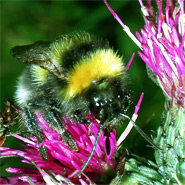Posted 30 March 2009
Irish biodiversity loss linked to intensive farming practices, study shows
The abundance and diversity of bees, birds and other species of insects and plants have suffered serious losses as a result of changing farming practices in Ireland, according to the findings of the Ag-Biota project, a five-year scientific study conducted by University College Dublin (UCD) on behalf of the Environmental Protection Agency (EPA).
Approximately 80 per cent of agricultural land in Ireland is devoted to grass-based farming systems. The increased use of machinery, the removal of hedgerows, and the greater use of chemicals has led to landscape simplification and degradation and, as elsewhere in much of Europe, a reduction in the diversity of species across the Irish countryside.
“While bumblebees as a group are still readily found on typical farmland, our findings reveal that their abundance and diversity on moderately-to-intensively managed farmland may have declined by at least 50 per cent over the past 20-30 years,” says Dr Gordon Purvis from the UCD School of Biology and Environmental Science who led the five-year Ag-Biota project.
Commenting on the research findings, Mr Larry Stapleton, EPA Director says, “What was different about this study was its focus on the intensively farmed countryside, which makes up a high proportion of the land in Ireland. The research gained important insights into how the biological diversity of such farmland can be efficiently measured.”
According to the findings from the Ag-Biota project, the richness and diversity of bird species during the breeding season is strongly linked to the ecological quality of Irish hedgerows.
“Where the ecological quality of the hedgerows has been reduced due to the intensification of farming, there has been a marked decline in the diversity of bird species in the breeding season,” says Dr Purvis.
Parasitoid wasps, which are important in natural pest regulation, were identified by the research as strong indicators of wider biodiversity and ecological change in agricultural grasslands. These wasps are hugely diverse and highly specialised parasites, their abundance and host specialisation provides an especially useful insight into the changing diversity of all other insect groups, and a key insight into the underlying causes of ecological change.
“This type of scientific research is critical to our understanding of the agricultural practices that effect biodiversity. The findings from this report show that there is clear scope to reintroduce biodiversity in agricultural habitats without compromising agricultural productivity or output,” says Larry Stapleton, EPA.
Mr. Stapleton continues, “This report actually demonstrates that there are key agronomic benefits to be gained from maintaining and enhancing diversity in the Irish countryside, including enhancement of the fundamental natural processes upon which agriculture depends such as the decomposition and recycling of nutrients and natural pest control.”
The final results of the five-year Ag-Biota project were presented to scientists, policymakers and other stakeholders at a special conference in Dublin on Friday 27 March 2009.
The project has made a significant contribution towards Ireland’s obligations under the Convention of Biological Diversity (CBD), and subsequent agreement by EU member states to halt the loss of biodiversity by 2010. The results will help guide the development of agri-environmental policy that will promote the very significant role of farmers as custodians and managers of our wider countryside.
The research was funded by the National Development Plan through the programmes of environmental research administered by the Environmental Protection Agency on behalf of the Department of the Environment, Heritage and Local Government.
Other findings from the Ag-Biota project:
- Aspects of farm management and condition can be used as surrogate indicators for the likely change in the status of biological populations within farmland. This insight has informed wider EU-funded research for agri-environmental policy evaluation.
- Breeding bird populations within field boundaries area significantly greater on dairy farms compared with non-dairy farms.
- Increased inorganic fertiliser use causes decreased efficiency of soil nitrogen utilisation and decreased efficacy of atmospheric nitrogen fixation by white clover in pastures.
- The pasture ecosystem is critically dependant on earthworm populations to ameliorate the impact of high stocking rates on soil structure.
- An investigative tool was developed that will continue to be of use in further studies of the ecology of the barley yellow dwarf virus (BYDV) and its vectors in the field.
EPA research
Environmental Research is currently funded under the EPA STRIVE Programme – Science, Technology, research and Innovation for the Environment.
Bumblebees
Bumblebees play a vital role in plant pollination. They pollinate about 80% of flowering crops, which account for about 33% of the human diet. Expressing the importance of the honey bee to the earth’s ecosystem, Albert Einstein once speculated: ‘if the bee disappeared off the surface of the globe, man would only have four years of life left’.

